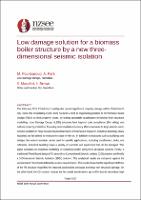| dc.contributor.author | Pourmasoud, M Masoud | |
| dc.contributor.author | Park, Alan | |
| dc.contributor.author | Mosaferi, Siamak | |
| dc.contributor.author | Brown, Iain | |
| dc.date.accessioned | 2021-06-22T04:01:49Z | |
| dc.date.available | 2021-06-22T04:01:49Z | |
| dc.date.issued | 2021-04-14 | |
| dc.identifier.uri | https://repo.nzsee.org.nz/xmlui/handle/nzsee/2339 | |
| dc.description.abstract | The February 2011 Christchurch earthquake caused significant property damage within Christchurch city. Since this devastating event, there has been a shift in engineering practice to Performance Based Design (PBD), to limit property losses, by setting acceptable acceleration thresholds from structural modelling. Low Damage Design (LDD) solutions look beyond code compliance (life safety) and address property protection, focussing on immediate occupancy after a moderate to large seismic event. Seismic isolation in New Zealand has become more commonplace; however, industrial buildings (dairy factories) are far behind to embrace this state-of-the-art. In addition to structures such as buildings and bridges, the seismic isolation can be used for specific applications, including transformers, tanks, and refineries. Industrial buildings have a variety of elements and equipment that can be damaged. This paper compares an analytical modelling of a biomass boiler using three structural systems. Firstly, a traditional Fixed Based design (FB) secondly a Conventional Seismic Isolated (CSI) solution and finally a 3-Dimensional Seismic Isolation (3DSI) solution. The analytical results are compared against the accelerations’ thresholds defined by seismic requirements. The results show that the significant stiffness of the FB structure magnifies the imposed acceleration and cause extensive non-structural damage. On the other hand, the CSI system reduces the horizontal accelerations up to 80% but do not reduce high vertical accelerations associated with Near Fault effects. The 3DSI system restrict the coupled horizontal-vertical responses to less than recommended thresholds. | |
| dc.language.iso | en | |
| dc.publisher | New Zealand Society for Earthquake Engineering | |
| dc.relation.ispartofseries | 2021;0167 | |
| dc.subject | Improving resilience of lifelines and infrastructure | |
| dc.subject | Resilience beyond life-safety and amenity | |
| dc.subject | Society, policy, and culture in understanding impacts and improving resilience | |
| dc.title | Low damage solution for a biomass boiler structure by a new three-dimensional seismic isolation | |
| dc.type | Article | |

